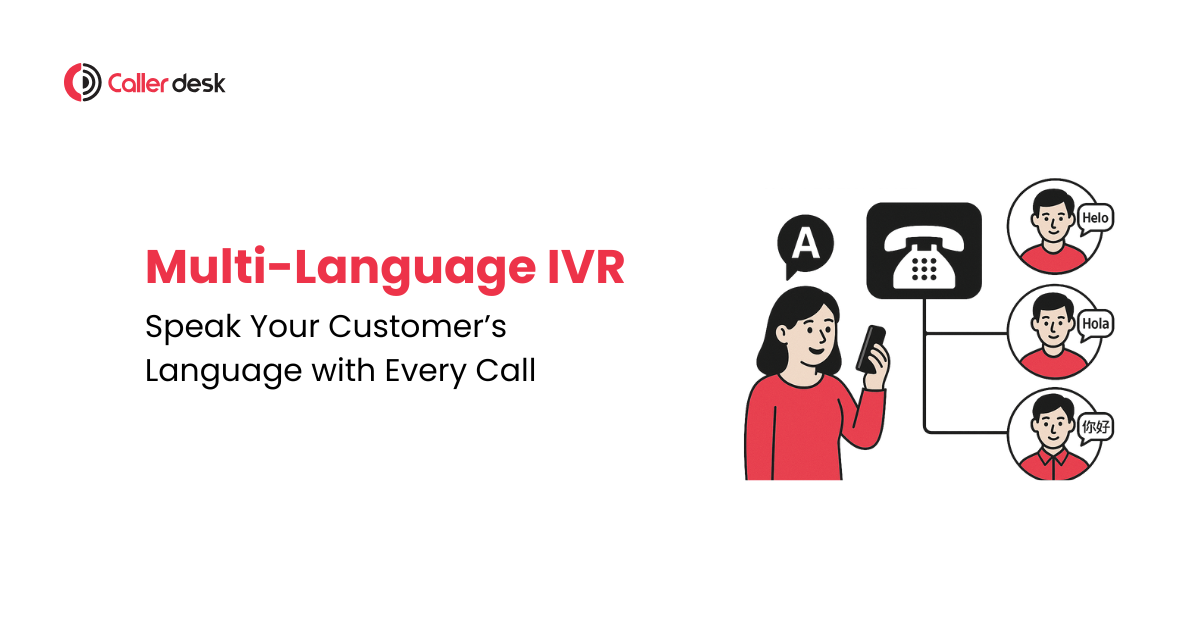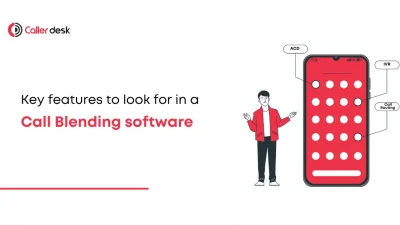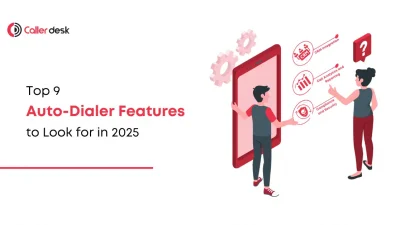India is home to 22 official languages and thousands of dialects. Your business might have customers from different states, backgrounds, and communities — all speaking different languages.
But what happens when your phone system only speaks English?
Customers feel confused.
They wait, unsure what to press.
Some hang up.
Some call again — only to drop off once more.
This is where Multi-Language IVR makes all the difference.
You can greet every caller in a language they understand — creating a smoother, friendlier, and more inclusive experience.
What is Multi-Language IVR?
The Multi-Language IVR feature lets you offer different language options in your IVR menu.
When someone calls your business, they hear:
“For English, press 1.
हिंदी के लिए 2 दबाएं।
मराठीसाठी 3 दाबा।”
After they choose their language, the rest of the call menu and voice prompts are played in that same language.
It’s like building one IVR tree with many language branches — all leading to the same teams, but in a language each caller feels comfortable with.
Why Multi-Language IVR Is Important in a Country Like India
Let’s take an example.
Naveen runs a loan company in Mumbai. His customers speak different languages:
- Shopkeepers prefer Hindi or Marathi
- Students are more comfortable with English
- Rural callers may only understand their native language
Earlier, his IVR was only in English. Many people:
- Hung up the call immediately
- Waited without understanding the options
- Needed extra help from support teams
After enabling Multi-Language IVR, his callers now choose the language they prefer.
The result?
- Fewer dropped calls
- Happier customers
- Less pressure on agents
Business Benefits of Multi-Language IVR
A Multi-Language IVR is not just a fancy add-on — it’s a powerful tool that improves the way your business talks to customers and handles calls. Here’s how it helps you grow:
1. Connect with More Customers Across India
India is full of language diversity. By offering voice support in Hindi, Marathi, Tamil, Telugu, Kannada, and more — you instantly make your service more accessible to a wider audience, including rural and regional customers.
2. Make Every Caller Feel Welcomed and Understood
When a caller hears the IVR in their own language, they feel respected and valued. It shows that your business cares enough to speak their language — and not just expect them to understand yours.
3. Reduce Confusion and Wrong Selections
Language barriers often lead to missteps like pressing the wrong option or getting stuck in the call flow. Multi-Language IVR solves this by guiding users clearly in the language they understand best, which reduces errors and frustration.
4. Build Stronger Trust and Brand Loyalty
Speaking in a caller’s local language makes your business feel more relatable and trustworthy. It helps create a positive brand image and builds loyalty, especially in communities where English isn’t the first choice.
5. Increase Call Completion and Self-Service Success
When people understand your menu, they’re more likely to stay on the call and complete the action — whether it’s placing an order, checking a delivery, or speaking to the right department. This leads to fewer call drops and better service outcomes.
6. Reduce Agent Workload
A clear, localized IVR helps users complete tasks on their own without needing help from agents. This means your support team can focus on important or complex issues, not repeat basic information.
7. Expand Your Business Easily in New States
Planning to grow into new regions? You don’t need to set up new call centers. Just add the local language to your IVR and serve new customers instantly — while keeping your backend processes the same.
Real Example: Delivery App Expands Across States
A food and parcel delivery app added Hindi, Tamil, Kannada, and Telugu to its IVR.
Before the update:
- Many calls were dropped before completing
- Customers needed agent help for simple tasks
After using Multi-Language IVR:
- 3x increase in successful self-service calls
- 40% fewer missed calls
- Better feedback from users in every region
All of this — just by letting people hear the system in their own language.
How CallerDesk Makes It Easy
Setting up a Multi-Language IVR might sound technical — but with CallerDesk, it’s surprisingly simple and fully customizable, even if you’re not from a tech background.
Here’s how CallerDesk makes the process effortless:
Step 1: Pick the Languages You Need
Select from a wide range of Indian languages like Hindi, Marathi, Tamil, Telugu, Kannada, Bengali, and more — based on the regions you serve.
Step 2: Add Your Voice Prompts
You can either record the IVR messages in each language using your own team or upload professional audio recordings. CallerDesk also offers voice-over support if needed.
Step 3: Design the IVR Journey
Use CallerDesk’s visual drag-and-drop IVR builder to map out the call flow. Link all language options to the same business departments or customize journeys per language as needed.
Step 4: Go Live in Minutes
Once your IVR is ready, hit publish — no coding, no complex setup. Your multilingual IVR goes live instantly.
Step 5: Track What Works
CallerDesk lets you track which language options are selected the most, how long callers stay, and where drop-offs happen — so you can keep optimizing for better results.
Conclusion
In a country as diverse as India, language is more than communication — it’s connection.
If your customers hear their language, they feel seen, respected, and included.
CallerDesk’s Multi-Language IVR helps your business:
- Reach more people
- Offer better service
- Sound professional and local — at the same time
Whether you’re serving five cities or fifty, this one feature helps you build stronger relationships with every caller.
Let your IVR speak the language of your customers — and watch your call experience transform.



